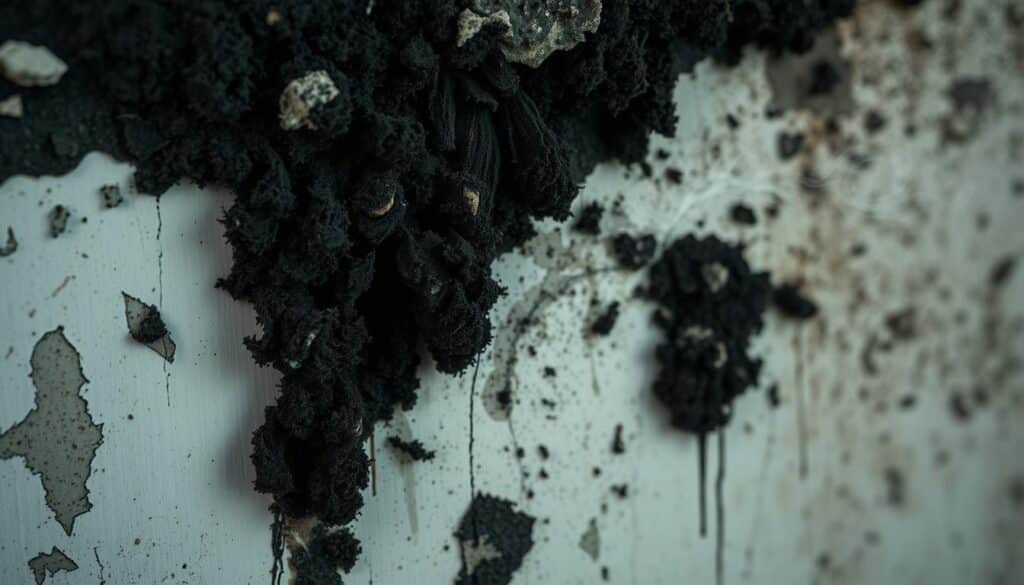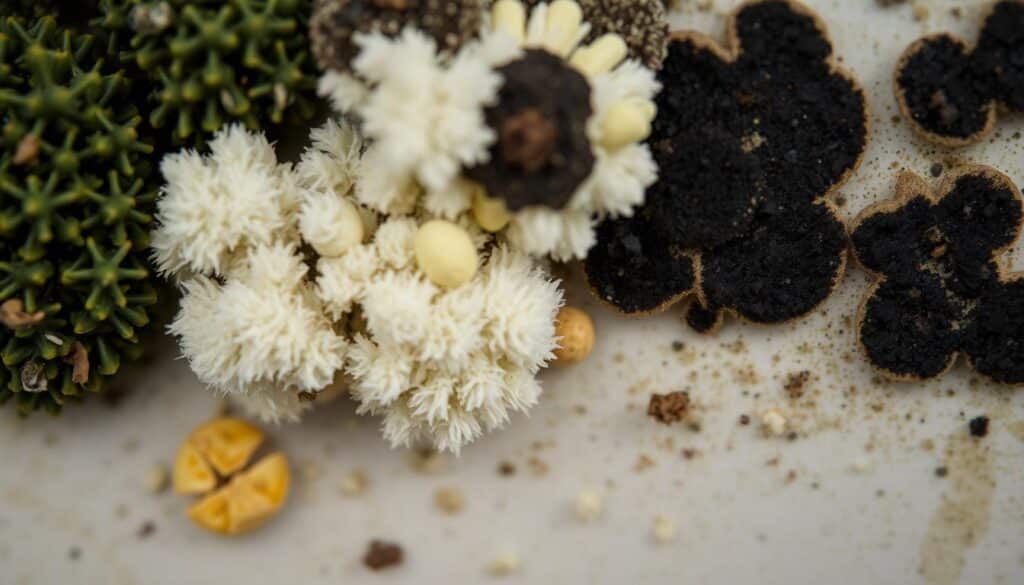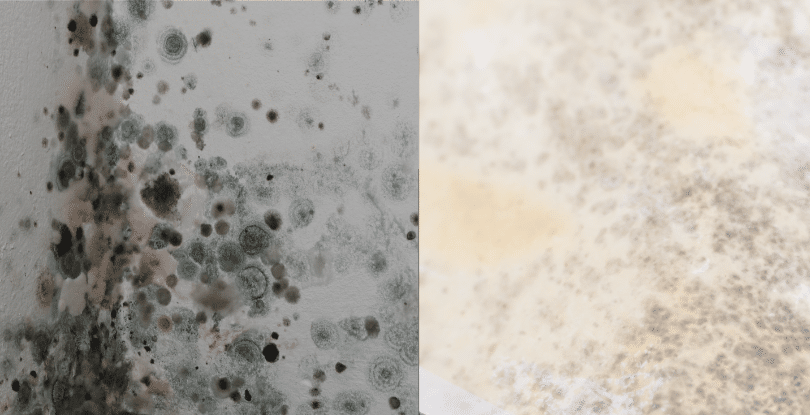Did you know that toxic black mold, known as Stachybotrys chartarum, is very dangerous? It can cause serious health problems. As a homeowner, it’s important to spot and deal with this fungus quickly. In this guide, I’ll show you how to find black mold, understand its health risks, and keep your home safe.
Key Takeaways
- Black mold, also known as Stachybotrys, is a highly toxic form of fungus that can cause severe health problems.
- Identifying black mold requires a keen eye, as it can easily be mistaken for other types of dark-colored mold.
- Exposure to black mold can lead to a range of symptoms, from mild respiratory issues to long-term neurological damage.
- Prompt action and professional remediation are essential for effectively removing black mold and preventing further growth.
- Maintaining proper moisture levels and addressing any water damage in your home are key to preventing black mold infestations.
What is Black Mold?
Stachybotrys chartarum: The Toxic Black Mold
Black mold, also known as Stachybotrys chartarum, is a harmful fungus. It produces toxins called mycotoxins. This mold is more dangerous than others, especially for people with asthma, allergies, or weak immune systems.
Stachybotrys chartarum is known as “toxic black mold.” It can release mycotoxins that harm your health. These toxins can cause skin irritation, headaches, and respiratory problems.
Black mold looks different from regular mold. It’s darker and has a furry or slimy texture. It also smells bad, like rotting wood. Plus, it’s hard to clean because it’s resistant to most products.
Exposure to black mold can lead to severe health issues like allergic reactions, trouble breathing, immune system problems, lung disease, and chronic fatigue.
Not all black molds are toxic. Some, like Cladosporium, Nigrospora, and Alternaria, are safe. But, it’s best to have a pro check the mold to avoid health risks.
Signs and Symptoms of Black Mold
Being around black mold, also known as Stachybotrys chartarum, can cause health problems. Common black mold symptoms include breathing issues, skin problems, and brain effects. Signs of black mold exposure include constant coughing, sneezing, watery eyes, and stuffy nose.
People with weak immune systems or health issues like asthma face bigger risks. Long-term exposure can make breathing problems worse or cause new ones. Some people might also experience confusion, memory loss, and mood swings due to black mold.
It’s vital to deal with suspected black mold right away. Ignoring it can harm your health and safety. Being alert and taking action to find and fix black mold can keep your home safe and your family healthy.
| Symptom | Description |
|---|---|
| Respiratory Issues | Coughing, sneezing, wheezing, and difficulty breathing. |
| Skin Irritation | Rashes, hives, and other forms of skin inflammation. |
| Neurological Effects | Confusion, memory loss, difficulty concentrating, and mood swings. |

The risk of black mold symptoms is higher for those with weak immune systems, allergies, or breathing problems. Quick action to find and fix black mold is key to keeping you and your family safe and healthy.
how to identify black mold
Visual Inspection and Testing
Finding black mold can be tricky because it looks different. It might be dark, slimy, or fuzzy, and can be black, dark green, or brown. Black mold usually grows in damp, humid spots and smells musty.
Looking for mold yourself can help, but getting it tested is best. You can buy mold test kits for $30 to $40. More advanced kits cost up to $90, while basic ones are just $10. But, sending a sample to a lab for a detailed check can cost an extra $40 to $70.
Getting a mold test kit and sending it to a lab can take 8 weeks. If you or your family is showing mold symptoms, getting a pro to check might be faster. It’s wise to hire experts for big or hard-to-reach mold problems to ensure it’s removed safely and right.
Keeping an eye on your home and fixing issues like bad ventilation or too much moisture can stop mold. By being proactive and using the right tests, you can identify black mold early and fix it before it gets worse.
Health Risks of Black Mold
Black mold, also known as Stachybotrys chartarum, can be very harmful. It’s especially dangerous for people with weak immune systems, breathing problems, or allergies. This fungus can release toxins that cause symptoms like breathing issues, skin problems, and even brain effects.
One big worry with black mold is how it can hurt your breathing. When you breathe in its spores, you might get asthma, cough, or have trouble breathing. If you’re already sick, it could get worse, leading to lung infections or brain damage.
Black mold can also cause a condition called “toxic mold syndrome.” This can make you feel tired, have trouble focusing, and feel muscle pain. While there’s no clear proof it causes cancer, scientists are still studying its long-term effects.
It’s very important to deal with black mold quickly. If you don’t, it can spread and harm more people.
“Exposure to black mold can have serious health consequences, especially for individuals with compromised immune systems, respiratory conditions, or allergies.”
In short, black mold is a big health risk that shouldn’t be ignored. It can cause serious problems, from breathing issues to brain effects. Being careful and quick to fix black mold problems is key to keeping a safe and healthy place to live or work.
Conducive Conditions for Black Mold Growth
Black mold, or Stachybotrys chartarum, loves damp, humid places with bad air flow. It grows and spreads because of moisture. Sources of moisture include leaks, floods, high humidity, and bad air circulation.
To stop black mold, keep air flowing well, control humidity, and fix water damage fast. Experts say humidity over 70% indoors leads to mold. Water leaks, poor drainage, or floods also cause mold inside.
Not venting well when showering or cooking adds to moisture and mold. Insulating walls well can stop mold on cold surfaces, especially in winter.
It’s key to fix moisture problems to stop black mold. Look for mold and its musty smell, even if you can’t see it. Fixing leaks and ensuring good air flow can prevent black mold growth.
Moisture, Humidity, and Poor Ventilation
- Mold growth is mainly about controlling moisture, with humidity over 70% indoors causing mold
- Water leaks, poor drainage, or floods lead to mold inside
- Not venting well when showering or cooking adds to moisture and mold
- Proper insulation of exterior walls can prevent condensation and mold on cold surfaces
By tackling the causes of black mold, like moisture and poor ventilation, landlords and tenants can stop and fix this harmful fungus. This keeps everyone in the building healthy and safe.
Identifying Black Mold vs. Other Types of Mold
Black mold, also known as Stachybotrys chartarum, is seen as the most dangerous. But, other molds can also be harmful. It’s hard to tell black mold from other household molds because they look similar. Black mold has a dark, slimy, or fuzzy look and smells musty.
Other molds, like Alternaria, Cladosporium, and Penicillium, come in white, green, or yellow. They have different textures and grow in different ways. For example, Cladosporium is common and can make allergies worse, but it’s not toxic. Alternaria can also cause severe allergies.
Black toxic mold, like Stachybotrys chartarum, makes harmful chemicals. These chemicals can be breathed in and cause health problems. It’s important to identify mold correctly to know how to fix it.
Wet materials need to be consistently moist for at least 72 hours for black toxic mold to grow. Improper ventilation, such as bathroom exhaust fans venting into the attic, can also lead to the growth of black toxic mold.”
Being exposed to black toxic mold can lead to breathing problems, rashes, and more. Symptoms include coughing, headaches, and tiredness. To prevent mold, find and fix the moisture problem. This means checking humidity, fixing leaks, and using dehumidifiers.

Professional Mold Inspection and Remediation
When to Call in the Experts
Homeowners can spot and try to remove small black mold spots. But for bigger or trickier mold problems, it’s wise to get help from mold inspectors and remediators. They have the right tools and know-how to find out how big the problem is, plan how to fix it, and make sure all mold is gone.
If the mold is big, hard to get to, or makes you worry about your health, get a pro. They can also find and fix the moisture issues that caused the mold. This stops it from coming back.
Studies show that about 70% of homes in the U.S. have mold. Stachybotrys, or black mold, is especially bad because of the toxins it makes. Getting your home checked for mold is key to knowing if it’s safe. And getting it removed by experts is important for your health.
Mold testing is essential to determine whether black mold in homes is toxic or non-toxic. Toxic black mold, such as Stachybotrys chartarum, can lead to serious health effects due to the mycotoxins it releases.” – MoldTech, Black Mold Removal Experts
Preventing Black Mold Growth
Keeping our homes healthy and free from mold is key to our well-being. The main way to stop black mold is to control moisture. By keeping our homes dry and well-ventilated, we can lower the risk of mold and keep our families safe.
To prevent black mold, it’s important to control moisture levels in our homes. We should keep humidity between 30-50%, fix water leaks quickly, and ensure good air flow in wet areas like bathrooms and kitchens. Regular cleaning and watching for mold signs can also help catch problems early.
Using mold-resistant materials and products can also help. This includes mold-inhibiting paints, mold-resistant drywall, and cleaning with mold-killing solutions. These steps can make our homes healthier and lower the chance of mold growth.
It’s vital to tackle the root cause of moisture to prevent black mold. By keeping our homes dry and watching for mold signs, we can protect our families and our homes. Let’s all work together to prevent black mold and make our homes healthier and more sustainable.
Common Areas for Black Mold Growth
Black mold, also known as Stachybotrys chartarum, is a fungus that can grow in many home areas. Knowing where it grows is key for homeowners to stop it.
Bathrooms are a big problem for black mold. They have water, darkness, and warmth, perfect for mold. Look for mold around the toilet, bathtub, and near water heaters.
Kitchens are also at risk. They have warmth, darkness, and dampness, great for mold. Check the dishwasher, refrigerator, and washing machine seals, dirty dishes, and sink cabinets.
Living rooms and home offices can also get mold. Paper documents and wet plants can attract mold. So, keep these areas dry.
Bedrooms are not safe from mold either. Old mattresses can grow mold. Attics and basements are also risky due to poor air and moisture.
Homeowners should check these areas often for mold. Fixing moisture problems quickly is crucial to stop mold.
“Mold spores can lead to symptoms such as stuffy nose, wheezing, and skin/eye irritation, as per the Centers for Disease Control (CDC). Longer exposure to black mold can result in more serious symptoms such as fever, shortness of breath, and nausea.
By being proactive, homeowners can protect their air quality and health. Focus on areas prone to mold growth.
Black Mold and Indoor Air Quality
Black mold is more than just a nuisance; it can harm the air we breathe. It releases harmful substances into the air, which can cause health problems. These problems include respiratory issues and allergic reactions.
The Centers for Disease Control and Prevention (CDC) says mold can lead to coughing and wheezing. It can also cause skin irritation, headaches, and fatigue. Some molds can even trigger allergic reactions and respiratory issues.
For people with asthma or weakened immune systems, mold is especially dangerous. It’s important to tackle mold problems to keep the air clean and healthy. This protects everyone’s health in the space.
Finding black mold can be hard because it often hides in unseen places. It may not even smell musty. DIY tests can help, but experts are best for accurate results, especially for big mold problems.
To fix mold issues, you need to dry out the area and use protective gear. This stops mold from coming back. By tackling mold, you make your indoor space safer and healthier for everyone.
“Exposure to black mold and its byproducts has been linked to a range of respiratory issues, allergic reactions, and other health problems.”
- Understand the health risks of black mold exposure
- Identify potential black mold growth in your home or building
- Hire a professional mold inspector for comprehensive testing and remediation
- Maintain a dry, well-ventilated indoor environment to prevent future mold growth
By tackling black mold and improving air quality, you protect your health and others’. Don’t let mold harm your space. Take steps to find and remove it for good.
Conclusion
Identifying and dealing with black mold in homes is key to keeping people safe and healthy. Knowing what black mold looks like and how to spot it is important. By taking steps to stop it from growing, homeowners can lower the risks it poses.
It’s important to act fast and get help from experts if needed. This is how you can get rid of black mold and keep your home healthy.
Black mold is hard to find because it hides in dark, small places. It grows fast, spreading more spores in the air. If you have symptoms like coughing, sneezing, or headaches, it might be because of black mold.
People with breathing problems or weak immune systems are at higher risk. Getting help from mold experts is crucial. They can find and fix the problem, but costs can vary a lot.
To keep your home safe and healthy, watch for signs of black mold. Act quickly if you find any. Working with mold experts is also key. By doing these things, you can protect your family from the dangers of black mold.
FAQ
What is black mold, and how is it different from regular mold?
Black mold, also known as Stachybotrys chartarum, is a toxic mold. It produces harmful mycotoxins. Unlike other molds, black mold is more dangerous, especially for those with asthma, allergies, or weakened immune systems.
What are the signs and symptoms of black mold exposure?
Exposure to black mold can cause respiratory problems, skin irritation, and neurological effects. Symptoms include coughing, sneezing, watery eyes, and nasal congestion. People with weakened immune systems or asthma may react more severely.
How can I identify black mold in my home?
Finding black mold is hard because it looks different. Look for a dark, slimy, or fuzzy appearance in black, dark green, or brown. It grows in damp areas and smells musty. Testing by professionals is best to confirm.
What are the health risks associated with black mold exposure?
Black mold exposure can be very harmful, especially for those with weak immune systems or respiratory issues. It can cause respiratory problems, skin irritation, and neurological effects. Long-term exposure can lead to lung infections, memory loss, and brain damage.
What conditions allow black mold to grow, and how can I prevent it?
Black mold grows in damp, humid places with bad ventilation. Fixing moisture issues is key to stopping and fixing black mold. Use ventilation, dehumidifiers, and fix water damage quickly to keep your home mold-free.
How do I differentiate between black mold and other common household molds?
Black mold is dangerous, but other molds can also be harmful. Black mold has a dark, slimy look and a musty smell. Other molds come in white, green, or yellow and look different. Identifying it right is important for the right treatment.
When should I call in a professional for black mold remediation?
Homeowners can handle small black mold spots. But for big or complex cases, get a mold expert. They have the skills and tools to safely and effectively remove the mold.
How does black mold impact indoor air quality, and why is it so important to address?
Black mold can badly affect indoor air quality. It releases harmful mycotoxins and spores. These can cause respiratory issues, allergic reactions, and other health problems. Fixing black mold is key to keeping the air clean and healthy in your home.




